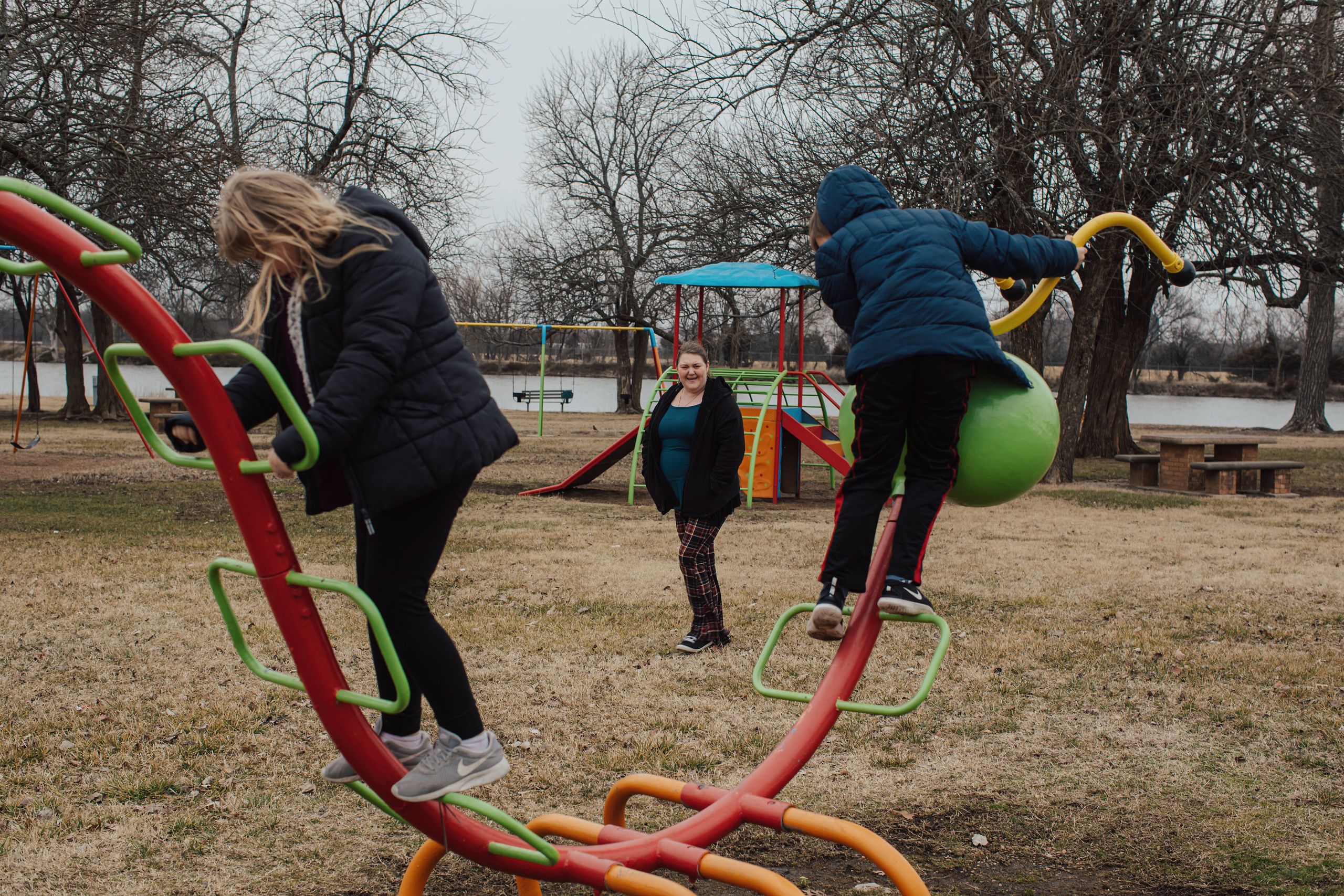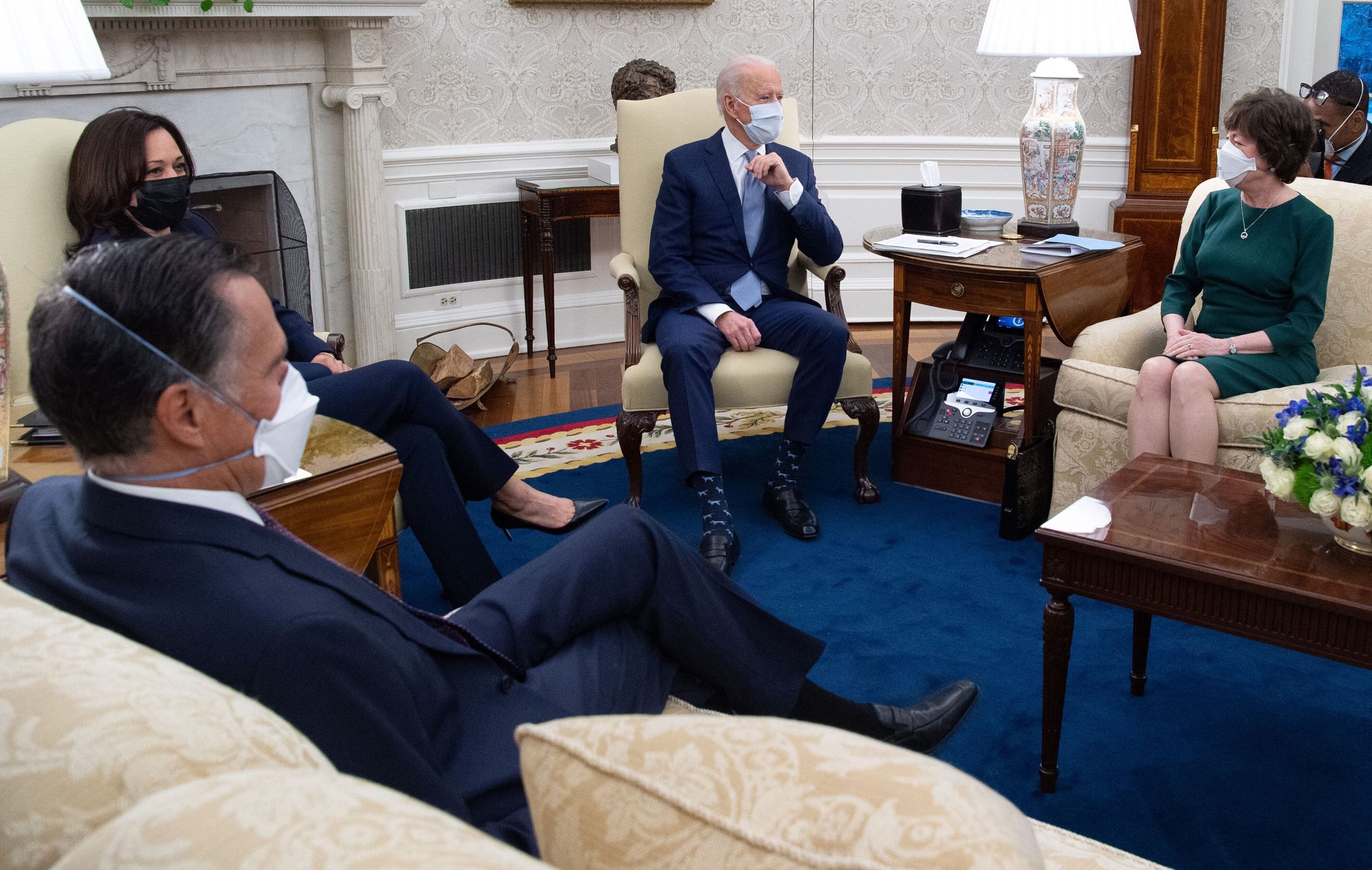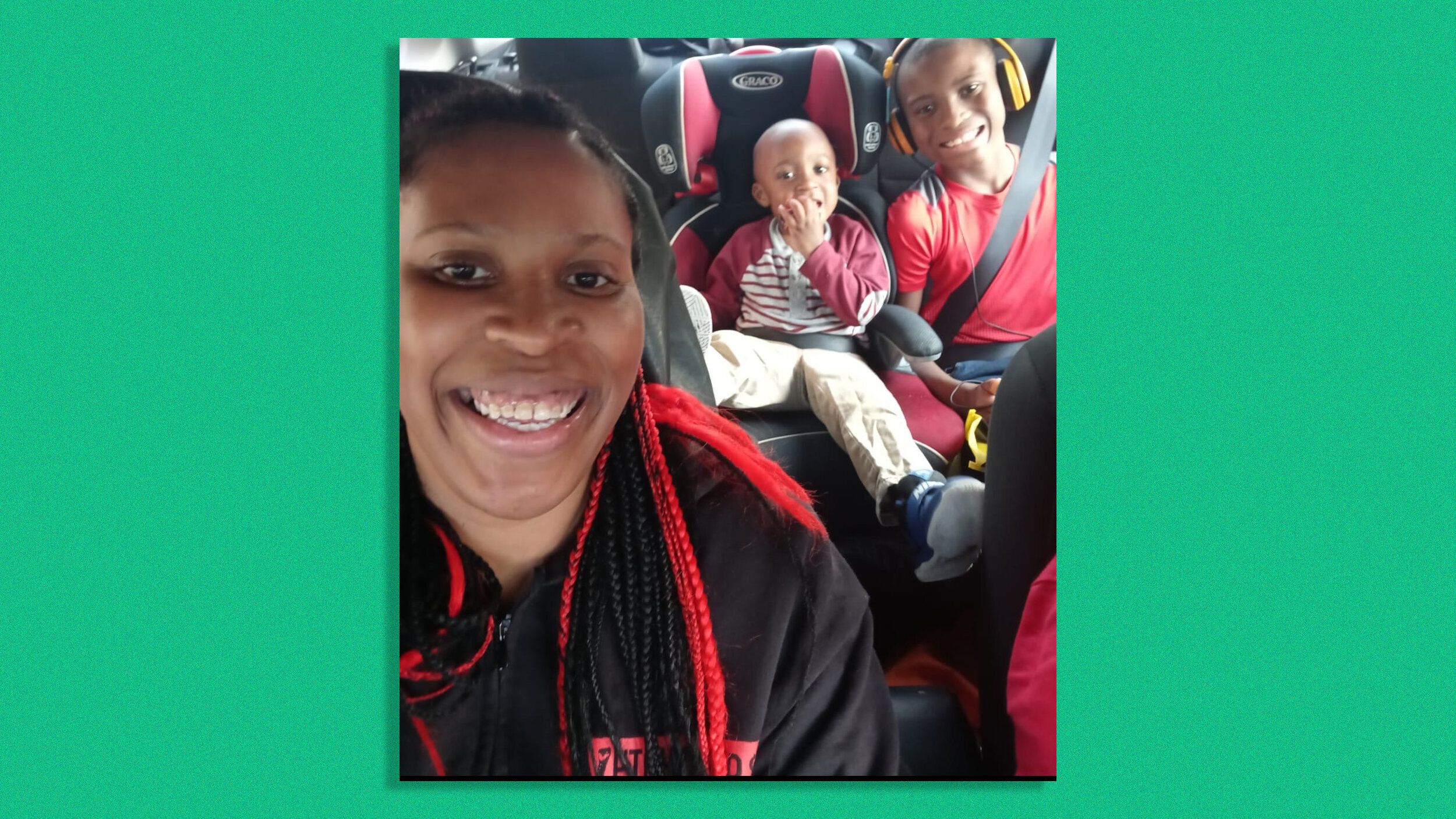[ad_1]
Tami Burch, a 40-year-old single mother in Chanute, Kansas, was just getting by before the pandemic hit. She has 10-year-old twins and was working 40 hours a week overseeing the kitchen in an assisted living facility. The pay was low, around $10 an hour, but she liked the work.
She’d bring the twins, a boy and a girl, along when her shift started at 6 a.m. They’d sleep on the couch in the front lobby, help bus tables or serve meals, or play on their tablets. Burch’s mother, a teacher, would pick them up and take them to school and then bring them back to the nursing home to finish out the afternoon.
Then COVID-19 struck. Schools closed and the nursing home went on lockdown ― no kids allowed. Burch had just returned to work in March after undergoing open-heart surgery. Her doctors told her she was at higher risk if she got the coronavirus. With no child care and a high-risk job, Burch had no choice but to take unpaid leave. Then her unemployment payments, which were meager but helpful, ended in October.
“We were already sitting on the edge, and they just kind of kicked us off,” she told HuffPost. “I just cry all the time because there’s no money.”
Even before the upheaval of 2020, most low-income parents in the U.S. were already living one crisis away from catastrophe, one child care emergency away from losing their jobs. They can’t count on the federal government for services and support available in other economically advanced countries as a matter of course.
At best, struggling parents in America have to navigate a confusing patchwork of partial, targeted programs ― which, in practice, means waiting months for a limited supply of subsidized child care slots to open, or making do with paid leave that was too short and came without replacement pay, or simply dropping out of the workforce with no certain source of income.
We were already sitting on the edge, and they just kind of kicked us off.
Tami Burch, single parent on unpaid leave
The struggles of working parents have received significantly more attention in Washington just in the last few years. A big reason is that 1 in 4 members of Congress are now women, double what it was 25 years ago. That includes Democratic senators like Patty Murray of Washington state and Elizabeth Warren of Massachusetts, each of whom has experience as both an educator and working mother of young children and has made child care programs a top priority.
These advocates for working parents now have a new, powerful ally in President Joe Biden ― who, unlike many men of his generation, has experience serving as the primary caregiver to his two sons after the tragic death of his first wife and daughter when he was a young senator in 1972.
Biden made caregiving a central part of his presidential campaign, partly because his personal experience made him aware of it and partly, as he has said frequently, because the circumstances of the pandemic have demanded it. True to his promise, his proposals for a coronavirus relief package included major new assistance for America’s parents in the form of billions for child care centers and paid parental leave.

The pandemic relief bill Biden and Democrats are now trying to pass would include these as well as new cash benefits for the majority of parents in the U.S. The policy could revolutionize the American safety net and slash child poverty.
Also in the bill is a proposed hike in the minimum wage, to $15 an hour, which would be life-changing for parents like Burch. There’s even talk about universal pre-kindergarten, which is a year of free, quality child care for parents who previously had to pay for it, although that would likely come under separate legislation.
It’s one thing to propose these things, quite another to enact them. Getting these programs through a Congress where Democrats have razor-thin majorities will require winning over some Republicans or, at the very least, holding the support of nearly every single Democratic lawmaker. And inevitable complaints are already making the rounds on Capitol Hill and on cable news that such an agenda would be too big, too partisan, too radical.
The pandemic has given lawmakers a chance to do what they could have done long ago: make life much less difficult for working parents and their children. But only if they don’t blow it.
Problems That Predate The Pandemic
Even before the pandemic, children had the highest official poverty rate of any age group in the U.S., mainly because parenting often means missing wages, which impoverishes parents, especially mothers, and by extension, kids. Although low-income families are eligible for a variety of government services and targeted subsidies, most can’t lean on a program like Social Security, which delivers monthly checks directly to retirees and has, over the years, dramatically reduced poverty among the elderly.
The pandemic has supercharged the problem by driving millions of women out of the workforce so they can care for children who are suddenly home from public school, the only reliable, free source of child care in the U.S. It has been especially tough on women who were struggling financially in the first place and can’t afford to hire extra help.
More than 3 in 5 low-income households with children reported some kind of “income shock” since the pandemic, like trouble paying bills, job loss and hunger.
This is bad for families, but it is especially bad for children. Early research suggests child poverty rose dramatically last year. The rate of food insecurity increased dramatically in households with kids since the start of the pandemic.
Burch is a case study in how this all plays out and why the existing supports from the government are so inadequate. She gets food benefits through the Supplemental Nutrition Assistance Program, which was sufficient when her kids were at school all day and could get free lunch, but a strain when everyone was home during early lockdown. (Both kids are back to in-person schooling now.)
And she received cash from the earned income tax credit and the child tax credit, two policies Congress has greatly expanded in recent decades to little fanfare.

Burch’s tax returns are a glimpse into how she managed before COVID-19. In 2019, she earned $18,000. And she received $5,828 from the earned income tax credit and $2,406 from the child tax credit as a one-time payment at tax time last year. That’s a nearly 50% increase in her wages.
Burch has done what she can to make money over the past year. She likes to paint in her spare time and was able to earn some cash selling her artwork, mainly portraits that she puts to canvas using spray paint.
But Burch was out of work in January and February 2020 because of her surgery, and back to work for only a couple of weeks before the pandemic-related shutdown. This year’s tax refund amounted to just $400, since the child credit only benefits workers with at least $2,500 in earnings, and the earned income credit only provides its maximum benefits for workers with between $10,000 and $20,000 in earnings.
Congress expanded unemployment benefits last March as part of its initial COVID-19 response, loosening eligibility rules and increasing benefits amounts, and that helped for a while. But lawmakers didn’t anticipate how long the crisis would last, and Burch’s benefits ran out in October. Congress finally got around to passing more benefits at the end of last year, but Kansas is one of many states that hasn’t yet restarted payments.
Even when the checks resume, Burch may not get one, at least right away, because the Kansas unemployment office has flagged her for fraud. It hasn’t sent a formal explanation in writing and she’s spent hours on the phone trying to understand why.
“They’re a mess,” she said of the whole process, explaining she calls the office daily.
Burch was eligible for a second stimulus payment, which was also part of the bill Congress passed late last year, and when she got the check in January, she stocked up on laundry detergent, trash bags, tissues and shampoo. She paid overdue bills. But that money is completely gone now.
“It filled a hole at best,” Burch said.
Giving People Money Is Beneficial And Popular
Biden and the Democrats campaigned on a promise to provide more help as part of a broader COVID-19 relief package, and just this week, they have formally started moving legislation through Congress. Their intention is to use the “budget reconciliation” process, which allows a simple majority in the Senate to pass legislation without the threat of a filibuster.
Democratic leaders have said they would like Republican support and, on Monday, Biden met with a group of 10 GOP senators who said they were interested in negotiating. But those senators envision a lot less spending, which means a lot less help for families, and by using the reconciliation process, Democrats could pass a bill on their own as long as all 50 members of the Senate Democratic caucus vote yes. (Vice President Kamala Harris would break the tie.)

The Democratic package includes a new round of stimulus checks and another extension of unemployment benefits, and those are the features that get most of the attention. But other provisions may have bigger, farther-reaching effects by transforming the way the federal government supports families — or at least by starting such a transformation.
Biden’s “American Rescue Plan” includes a proposal to increase the child tax credit from $2,000 to $3,600 per child and to allow families with no income to qualify. The increase would last only one year, but champions of the idea have said they hope legislation later in 2021 would then make the increase permanent.
The plan excites Democrats on Capitol Hill and social policy experts because it resembles the American Family Act, a recent bill by Sens. Sherrod Brown (D-Ohio) and Michael Bennet (D-Colo.) that would enlarge the credit by the same amount and also pay it in monthly installments instead of annually.
The impact would be huge, with parents getting $300 per month per child. According to an analysis of the proposal from Columbia University’s Center on Poverty & Social Policy, the monthly cash would slash poverty among children 42% — because it turns out poverty is caused by a lack of money.
We shouldn’t have to spend our pandemic checks on all our bills if they’d paid us what we’re worth.
Ieshia Townsend, working parent and Fight For $15 leader
Until recently, the idea of simply giving people money, especially poor people, was politically taboo. In 1996, the Republican Congress passed and former Democratic President Bill Clinton signed a welfare “reform” bill that basically ended direct cash assistance.
That move followed decades of political attacks, many of them racist, that suggested welfare payments used tax money from hard-working people to subsidize the indolent. The only way to increase assistance for families was to hide it in the tax code through various sorts of breaks ― of the sort that Burch got on her taxes last year ― that were inevitably less available and less effective at reaching people who needed help.
But with the pandemic forcing so many people out of the workplace for the sake of public health, Congress signed off on direct payments as part of its initial COVID-19 relief package. And perhaps because the payments went to such a broad swath of Americans, with more than 200 million getting checks, the assistance has proven wildly popular ― and may even help explain why approval ratings for Congress in May hit 31%, a level not reached since 2009.
Reducing people’s material suffering, it turns out, can be both beneficial and popular.
Other rich countries, by the way, figured this out a long time ago. Almost all of them pay parents a monthly child benefit or child allowance and almost all have way lower child poverty.
Just how far Biden is determined to run with this idea remains to be seen. His outline for a pandemic relief bill does not call for advance monthly payments, which is so critical for reaching people in need. And it does not formally call for extending the increase in the child tax credit past a year. The White House did not respond to questions about whether Biden supports either advance payments or making the checks permanent.
But champions of the idea in Congress have made clear their intentions. House Ways and Means Committee Chair Richard Neal (D-Mass.) said, in a statement to HuffPost, that expanding the child tax credit has been a long-term goal and that Democrats are exploring ways to make it “even more beneficial for folks who are struggling during these exceptionally difficult times.”
A new monthly benefit for children is an appropriate answer to the pandemic’s extraordinary burden on parents, and lawmakers know it, said Samuel Hammond, the director of poverty and welfare policy at the Niskanen Center, a moderate think tank that has helped lawmakers of both parties craft policies to benefit parents.
“Don’t count your chickens before they hatch, but the momentum behind the child allowance is real,” he said.
Parents With Jobs Need Help, Too
Many parents who have jobs right now could also benefit from the relief measures.
Ieshia Townsend and her husband are raising two children in Chicago. They’ve worked throughout the pandemic ― four jobs between them. She works at McDonald’s full time and drives for delivery apps like Instacart, Postmates and Uber. He works as a janitor at a local school and also keeps up an app side hustle.
It’s just enough to meet monthly expenses, she said. When the family got their most recent stimulus check, it all went to bills, said Townsend, who is also a leader in the labor group Fight for $15.
“We shouldn’t have to spend our pandemic checks on all our bills if they’d paid us what we’re worth,” she said.
Townsend’s days are grueling. She’s up before 5:00 a.m., getting the day’s meals together. She does a monthly food shop, planning meticulously for the coming weeks. Dinner was salmon, rice and broccoli on the day HuffPost spoke with her last week.

Her oldest child is doing virtual school in a center near the McDonald’s where she works, and her toddler is in a center nearby as well.
On weekends and after hours, the kids come along while Townsend makes deliveries.
“We laugh in the car,” she said. “Or we take tablets and do a movie day in the car. We try to make it as much fun as we can with them. You don’t get those days back.”
The family has dinner together in the evening before Mom or Dad heads out for a delivery shift. Townsend and a friend also help each other out by babysitting the other’s kids.
Townsend said she believes hourly workers like her and her husband deserve a living wage, paid leave, medical benefits. And a monthly income boost might allow her to actually spend more time with her family. “We’re making ends meet because I pick up all these extra delivery jobs,” she said. “I shouldn’t have to do that.”
But Are Politicians Ready For This?
Biden has said that helping people like the Townsends and Tami Burch and her kids are a top priority. And he has surrounded himself with advisers who seem to think the same way.
Heather Boushey, an appointee for the Council of Economic Advisers, is one of the nation’s leading experts on the financial strain of parents with young children and the caregiving economy. Neera Tanden, the veteran Democratic policy adviser Biden taped to run the Office of Management and Budget, is a longtime advocate for universal child care.
But for the pandemic relief bill or any future legislation, the question comes down to political will ― which, in turn, will depend on individual members of Congress, along with Biden’s ability and willingness to push them. The Democratic caucuses of both chambers are still full of members who flinch at the idea of too much spending or fear attacks that they support welfare, or for one reason or another (including dated views on gender roles), still don’t grasp the burdens that working parents really face. The politics of supporting working families have changed, but it’s not clear they’ve changed enough.
Calling all HuffPost superfans!
Sign up for membership to become a founding member and help shape HuffPost’s next chapter
[ad_2]
Source link